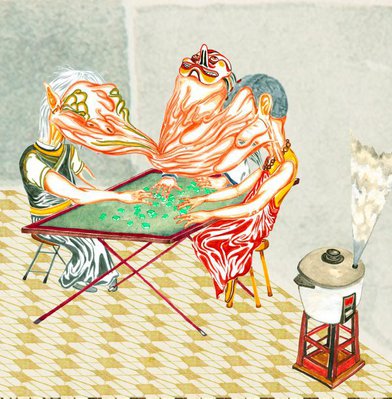







-
Details
- Place where the work was made
-
Vancouver
→
British Columbia
→
Canada
- Date
- 2017
- Media category
- Time-based art
- Materials used
- algorithmic animation sequence, five channel video projection, six channel audio
- Edition
- 2/4
- Dimensions
- 340.0 cm x 2418.0 cm preferred scale; 244.0 cm x 1735.0 cm minimum scale
- Signature & date
Signed l.c. Certificate of authenticity, black ink "Howie Tsui". Not dated.
- Credit
- Purchased with funds provided by the Asian Art Collection Benefactors 2018
- Location
- Not on display
- Accession number
- 136.2018
- Copyright
- © Howie Tsui
- Artist information
-
Howie Tsui
Works in the collection
- Share
-
-
About
'Retainers of Anarchy' is a 25-metre-long animated video scroll, showing scenes from historic stories and modern life within ‘parallel universes’. Read right to left, there is no linear narrative and the work never repeats itself, having no beginning or end as it is run on an algorithm. The animation pictorially references major works of Chinese art, including the Song dynasty (960-1279) handscroll, 'Along the River during the Qingming Festival' by Zhang Zeduan (1085–1145); 'The Water Margin' bandit stories set during the Song dynasty [Jp: Suikoden]; and the Qing dynasty (1644-1912) painting 'One Hundred Horses', 1728, by Giuseppe Castiglione (Lang Shining, 1688 –1766). Modern life emerges in the context of a 20th century Hong Kong under British rule with the inclusion of the Kowloon Walled City demolished in 1994. Both Song period China and the Walled City embody ideas of self-determined rules of conduct, resistance of authority and explores people on the fringes.
Howie Tsui (Tsui Ho Yan) was born in Hong Kong, raised in Nigeria and now lives in Canada. His work is strongly influenced by martial arts fictional stories (Mandarin as 'wuxia'; Cantonese as 'mou hap') of heroes, wanderers and drifters. These types of stories in the form of novels, movies, comics, and television series had been readily available through VHS video during the 1970s and 1980s in Hong Kong, Taiwan, Macau, Singapore and other Chinese diasporic communities overseas, but not in mainland China until the late 1990s. One of the most popular writers of the wuxia genre was the well-known Chinese author Louis Cha Leung-yung (b. 1924) known by his pen name Jin Yong. Tsui was highly influenced by the protagonists and characters in Jin Yong’s fictional stories such as the 'Condor Trilogy' ('Shè diāo sanbuqu') written between 1957-1963. These stories had become so much a part of popular culture in the region that they were retold in the form of TV series, radio dramas and often translated into various languages, making it accessible to a new and wider audience.
The universe Tsui creates in parallel is that of the Kowloon Walled City (KWC). It was situated on 2.6 hectares of land very near the old Hong Kong Kai Tak airport. KWC was demolished in the 1990s before the return of the colony by the British to People’s Republic of China in 1997. Historically the walled city can be traced back to the Song dynasty when it was an outpost in the business of selling salt. After Hong Kong was leased to Great Britain in 1898 for 99 years, the walled enclave was an anomaly having been excluded from the agreement. After the Japanese occupation of Hong Kong and then the Chinese civil war, a number of refugees squatted on the land. By the 1950s a number of crime syndicates moved in, and by the 1960s developers were constructing addition upon addition to existing buildings, until there was no possibility of building over 14 storeys due to height restrictions imposed by the airport. In the 1970s and 1980s KWC was one of the most densely populated places on earth with 33,000-40,000 occupants living within a city which was a world full of vice, crime and people living by their own rules.
This universe of characters Tsui has created belong to 'gong wu' (Mandarin: 'jianghu') the society of martial artists in 'wuxia' stories, these days also branded as triads. The societies were historically situated at the end of the Song dynasty and consisted of outlaws, outcasts, thieves, beggars and the like. Many of these itinerant outlaws wandered village to village, encountering heroes, warriors and knights who showed off skills such as flying in the air, archery, swordplay, and who fought for justice against the anarchic tyrants. Tsui shows these societies through vignettes of stories zooming in and out of scenes, whether it be a Song dynasty line up of warriors or the intimate apartment group of men playing mah-jong in the KWC as a rice cooker steams away.
-
Exhibition history
Shown in 2 exhibitions
Howie Tsui: Retainer of Anarchy, Vancouver Art Gallery, Vancouver, 04 Mar 2017–28 May 2017
Howie Tsui: Retainer of Anarchy, Ottawa Art Gallery, Ottawa, 01 Feb 2019–12 May 2019
Howie Tsui: Retainer of Anarchy, Art Gallery of Greater Victoria, Victoria, Jan 2020–Apr 2020
Outlaw, Art Gallery of New South Wales, North Building, Sydney, 03 Dec 2022–06 Jun 2023
-
Bibliography
Referenced in 1 publication
-
Diana Freundl, Michelle S. Gewurtz and Michelle Jacques (Editors), Howie Tsui: Retainers of Anarchy, Canada, 2017.
-

